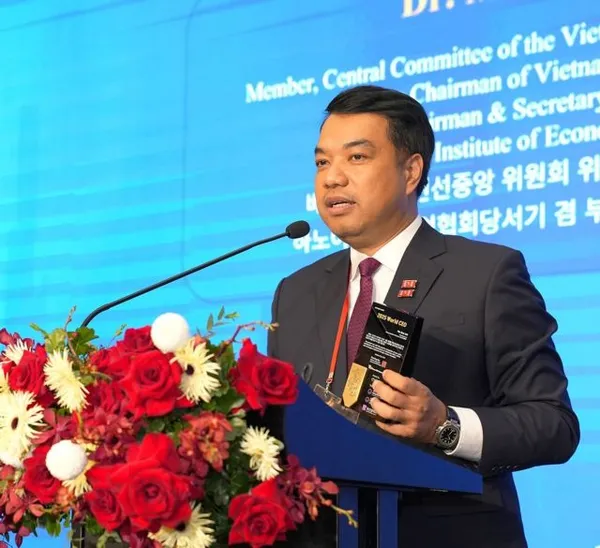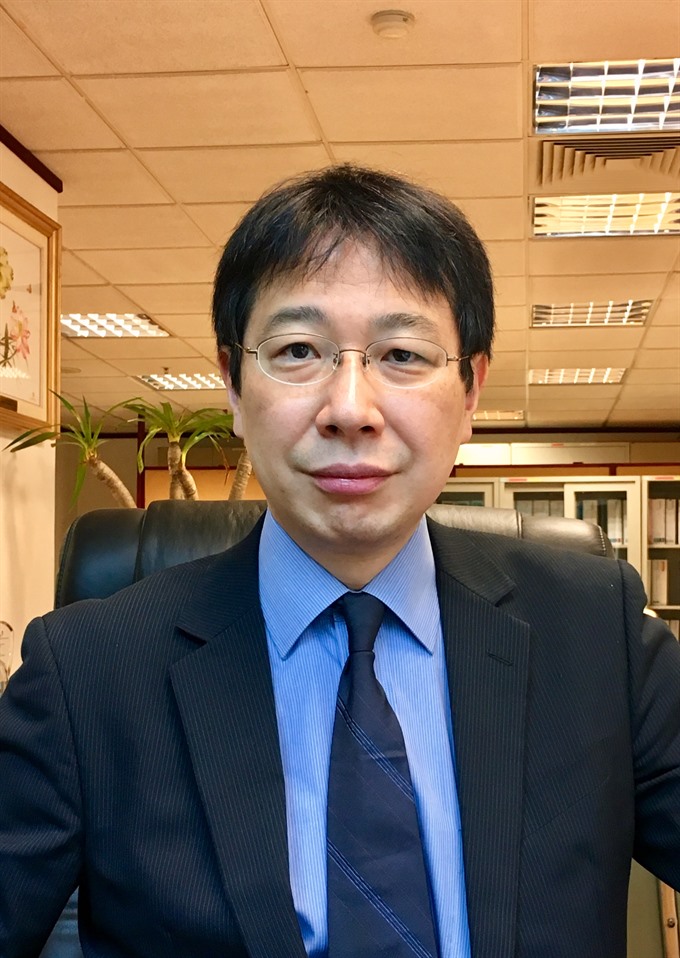 Talking Shop
Talking Shop

Việt Nam News reporter Ngọc Bích talks about the JBIC FY2016 Survey with Deputy Director General of the Policy and Strategy Office for Financial Operations Noriyasu Yuge, who used to be the Chief Representative of JBIC Office in Hà Nội.
" />A survey report by Japan Bank for International Cooperation (JBIC) has revealed that Việt Nam ranks among the top five countries preferred by Japanese firms for overseas business operations.
Việt Nam News reporter Ngọc Bích talks about the JBIC FY2016 Survey with Deputy Director General of the Policy and Strategy Office for Financial Operations Noriyasu Yuge, who used to be the Chief Representative of JBIC Office in Hà Nội.
 |
| Noriyasu Yuge, Deputy Director General of the JBIC’s Policy and Strategy Office for Financial Operations. — Photo Courtesy of JBIC |
A survey report by Japan Bank for International Cooperation (JBIC) has revealed that Việt Nam ranks among the top five countries preferred by Japanese firms for overseas business operations.
Việt Nam News reporter Ngọc Bích talks about the JBIC FY2016 Survey with Deputy Director General of the Policy and Strategy Office for Financial Operations Noriyasu Yuge, who used to be the Chief Representative of JBIC Office in Hà Nội.
Could you tell our readers about the objective and execution of the survey?
The survey was conducted by sending questionnaires to 1,012 manufacturing companies that have three or more overseas affiliates in July 2016. From July to September 2016, 637 companies returned them with valid responses.
The objective of the survey is to research the current trends, agenda and outlook of the overseas business operations of internationally active Japanese manufacturing companies.
After considering the findings of this survey, JBIC will support the overseas business activities of Japanese firms, while holding dialogues with host country governments, in an effort to improve their investment climate.
Could you highlight the results of Việt Nam’s ranking, in terms of Japanese expectations for business operations?
In general, 32.7 per cent of respondents chose Việt Nam as one of the top five countries that have promising prospects for medium-term business operations, taking the country to the fourth place in the 2016 survey from its fifth place in 2015, after India, China and Indonesia.
The proportion is 5.2 percentage points higher than the previous year. This is the second highest increase after India, which had an increase of 7.2 percentage points.
In the small and medium enterprises (SMEs) category, Việt Nam’s ranking is higher. It holds the second place with the percentage share of respondents (37.1 per cent) hitting its highest level in five years, up from the fourth in 2015.
Most SMEs engages in labour intensive industries, and Việt Nam has advantages in these sectors.
In the long-run, Việt Nam remains in the fourth place.
By industry wise category, Việt Nam ranks third as a promising country in the electrical equipment and electronics and the general machinery industries, fifth in the chemicals sector and seventh in the automobiles field.
What are the reasons for Việt Nam to be chosen as a promising place?
Most of the companies choose Việt Nam because they see growth potential in the local market, as well as its current size.
As you may know, Japan’s economic growth rate over the past two or three decades was low, around 1 and 2 per cent and its population is now shrinking. Therefore, many Japanese enterprises are keen on the opportunities to capture overseas market and to disperse their production base overseas for optimising global supply value chain.
However, compared with Japan’s total manufacturing Foreign Direct Investment (FDI) all over the world, the share of FDI in Việt Nam is still modest. Over the past three years, the share has jumped up, but it is still below 4 per cent. This sharply contrasts with the high expectation of Japanese companies.
Stability of the social and political situation in the country, and its cheap and qualified human resource are also taken into consideration. However, the percentage of companies saying that they chose Việt Nam because of its labour source, and social or political situation, decreased over the year.
For SMEs, Việt Nam’s position is higher, meaning that it is more favoured by them. However, over the past years, the “inexpensive source of labour” is gradually no longer cited as the top reason for being promising. Could you further explain the contradiction?
The comparative advantages of investment environment are changing dynamically. Some five or 10 years ago, many Japanese firms in general focussed on cheap labour force. It used to be a great attraction, but now it is important in some cases, but not always.
Japanese SMEs is labour intensive, but they also need skilled, experienced workers. We have a strong manufacturing industry and SMEs in the sector need technology transfer for their overseas produciton . They have to share all their own technology and know-how to the host countries.
Việt Nam now is the biggest producer of footwear and assembler of mobile phones. These are labour intensive sectors, while Japanese companies are more capital intensive. So, cheap labour is more important for Nike or Samsung, for example, but not always for us, quality of workers also matters.
The country needs to change its growth model from one dependent on increase of input, such as labour force and capital, to one driven by progress of efficiency and technology.
Do you think that the rise of Việt Nam’s position in medium term is closely linked to the Japanese entrepreneurs’ expectation of the ratification of Trans Pacific Partnership deal in which Việt Nam is a member?
I think there is some impact but Việt Nam position has been highly ranked for a past decade long before TPP negotiation.
Looking at the survey, you can see that the ratio of support to Mexico, which is also a TPP country, was very low in 2011. After that, it jumped up. It is not necessary the outcome of TPP expectation, but because Japan’s major car manufacturers such as Honda and Mazda started production in Mexico. First-tier and second-tier, and components companies also intend to invest in Mexico. That spurred Mexico’s ranking.
Recently, economists have warned of the return of protectionism which could affect firms’ decision to expand business abroad. Meanwhile, Việt Nam is also determined to improve its investment environment to lure more foreign investors. Under the situation, what do you think about Việt Nam’s ranking prospect in the future?
Obviously, some major economies are now seeking their own ways to set up tariff barriers or impose more restrictions on investment and trade. Maybe this kind of environment makes business more uncertain but Japanese companies will continue to seek overseas activities for further growth.
Việt Nam still has the potential to get higher ranking in the future, but it will take time. There are no quick solutions to improve the investment climate and it also takes time to improve the quality of human resources. In short, efforts should be devoted.
From the survey results, what do you recommend Việt Nam should do to further improve its business and investment environment?
An existing issue in Việt Nam is the execution of its legal system. In more details, regulations are not always transparent, consistent or adequate. Administrative procedure is sometimes lengthy and unclear. The Vietnamese Government needs to define regulations better.
Another thing is the underdeveloped infrastructure. Of course, recently we have not experienced breakout or suspension of electricity. Stable provision of electricity is a concern because the demand for power is increasing, especially in the southern areas. The area is attractive for FDI. In addition, despite improvements, transport infrastructure is still lagging in comparison with other Asian countries.
JBIC’s operation in Việt Nam is also to support initiatives of infrastructure enhancement in localities. For examples, we are providing financial aids for the construction of several power plants along the country as well as arranging loans for Japanese companies to invest in Việt Nam.
In conclusion, I would like to highlight that Việt Nam’s share of Japanese FDI is still modest despite the investors’ high expectation, so it is necessary to bridge this gap. If the Government continues to improve the investment environment and support FDI enterprises, the gap will be narrowed.
Việt Nam is chasing Thailand, Indonesia and China, but the country is also chased by Myanmar, Cambodia and Laos. So it is an endless competition for FDI. — VNS